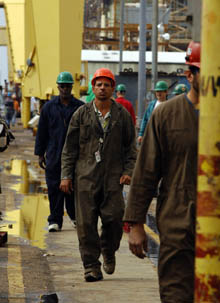Faculty Study Impact of Shipyard Shutdown
For more than 70 years, Avondale Shipyard has been a major economic driver in New Orleans. Now that there are plans to close the shipyard by 2013, a group of local professors is taking a look at what impact the shutdown will have on the region.

Avondale Shipyard represents about one percent of the roughly 520,000 jobs in the seven-parish New Orleans metropolitan area. (Photo by Cheryl Gerber )
This summer, at the urging of the AFL-CIO, three professors from Tulane Aaron Schneider, Jana Lipmann and Thomas Adams along with faculty members from Loyola University, the University of New Orleans and Southern Universityâ“New Orleans, will survey current and former shipyard employees. They want to understand the economic effects, as well as the non-financial repercussions, of the shipyard and its potential closure on the more than 5,000 people who work there.
Schneider, the Jill H. and Avram A. Glazer Professor of Social Entrepreneurship, will examine the role of the shipyard on civic engagement in the community.
“People who have good jobs, who participate in organizations like unions, also tend to participate in other organizations,” Schneider says. “This is important to our citizenship and our democracy. The worry there is the shutdown will have a chilling effect on community engagement.”
While the economic aspect will be the major focus for those in the region who don't work at the shipyard, Schneider argues that there could be long-lasting social impacts. For many, Avondale provided a path to the middle class, and during its history workers there have played a role in fighting for civil rights and women's rights.
Schneider says the shutdown offers a unique opportunity to raise questions about a major industrial closure before it happens, rather than doing a postmortem.
“I don't know that anyone has ever come in at this stage to track the effects as a firm makes plans to shut down and eliminate jobs,” Schneider says. “This is an situation where we can look at the people during the process, see how they respond and hopefully lend a hand.”
